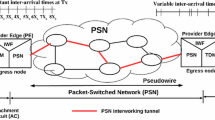Abstract
This paper studies the impact of long-range-dependent (LRD) traffic on the performance of a network multiplexer. The network multiplexer is characterized by a multiplexing queue with a finite buffer and an M/G/∞ input process. Our analysis expresses the loss probability bounds using a simple relationship between loss probability and buffer full probability. Our analysis also derives an exact expression for the buffer full probability and consequently calculates the loss probability bounds with excellent precision. Through numerical calculations and simulation examples, we show that existing asymptotic analyses lack the precision for calculating the loss probability over realistic ranges of buffer capacity values. We also show that existing asymptotic analyses may significantly overestimate the loss probability and that designing networks using our analysis achieves efficient resource utilization.
Similar content being viewed by others
References
B. Bensaou, J. Guibert, J. Roberts and A. Simonian, Performance of an ATM multiplexer queue in the fluid approximation using the beneš approach, Annals of Operations Research 49 (1994) 137–160.
J. Beran, R. Sherman, M. Taqqu and W. Willinger, Long-range dependence in variable-bit-rate video traffic, IEEE Transactions on Communications 43 (1995) 1566–1579.
A. Borovkov, Stochastic Processes in Queueing Theory (Springer-Verlag, 1976).
D. Cox, Long-range dependence: A review, Statistics, An Appraisal: Proceedings of a Conference Marking, (1984) pp. 55–74.
D. Cox and V. Isham, Point Processes (Chapman and Hall, 1980).
M. Crovella and A. Bestavros, Self-similarity in world wide web traffic: Evidence and possible causes, IEEE/ACM Transactions on Networking 5 (1997) 835–846.
N. Duffield, Queueing at large resources driven by long-tailed M/G/∞-modulated processes, Queueing Systems 28 (1998) 245–266.
N. Duffield, J. Lewis and N. O’Connell, Predicting quality of services for traffic with long-range fluctuations, in: Proceedings of IEEE ICC’95 (1995).
R. Gamkrelidze, Integral Representations and Asymptotic Methods (Springer-Verlag, 1989).
M. Garrett and W. Willinger, Analysis, modeling and generation of self-similar VBR video traffic, in: Proceedings of ACM SIGCOMM’94, (1994) pp. 269–280.
P. Jelenkovic, Subexponential loss rates in a GI/GI/1 queue with applications, Queueing Systems 33 (1999) 91–123.
P. Jelenkovic and A. Lazar, Asymptotic results for multiplexing subexponential on-off processes, Advances in Applied Probability 31 (1999) 394–421.
P. Jelenkovic and P. Momcilovic, Asymptotic loss probability in a finite buffer fluid queue with heterogeneous heavy-tailed on-off processes, Annals of Applied Probability 13 (2003).
H. Kim and N. Shroff, Loss probability calculations and asymptotic analysis for finite buffer multiplexers, IEEE/ACM Transactions on Networking 9 (2001) 735–768.
L. Kleinrock, Communication Nets: Stochastic Message Flow and Delay (MgGraw-Hill, 1964).
M. Krunz and A. Makowaski, A source model for VBR video traffic based on M/G/∞ input processes, in: Proceedings of IEEE INFOCOM’98 (1998).
N. Krylov, Introduction to the Theory of Diffusion Processes (American Mathematical Society, 1994).
W. Leland, M. Taqqu, W. Willinger and D. Wilson, On the self-similar nature of ethernet traffic (Extended Version), IEEE/ACM Transactions on Networking 2 (1994) 1–15.
N. Likhanov and R. Mazumdar, Cell loss asymptotics for buffers fed with a large number of independent stationary sources, Journal of Applied Probability 36 (1999) 86–96.
N. Likhanov and R. Mazumdar, Cell loss asymptotics in buffers fed by heterogeneous long-tailed sources, in: Proceedings of IEEE INFOCOM’00, (2000).
N. Likhanov, B. Tsybakov and N. Georganas, Analysis of an ATM buffer with self-similar (“Fractal”) input traffic, in: Proceedings of IEEE INFOCOM’95, (1995).
G. Lin, T. Suda and F. Ishizaki, Performance analysis of reassembly and multiplexing queueing with long-range-dependent input processes, Telecommunication Systems 20 (2002) 33–58.
G. Lin, T. Suda and F. Ishizaki, Performance analysis of a finite buffer network multiplexer with long-range-dependent input traffic, Preprint, (2002).
Z. Liu, P. Nain, D. Towsley and Z. Zhang, Asymptotic behavior of a multiplexer fed by a long-range dependent process, Journal of Applied Probability 36 (1999) 105–118.
M. Mandjes and J. Kim, Large deviations for small buffers: An insensitivity result, Queueing Systems 37 (2001) 349–362.
I. Norros, On the use of fractional brownian motion in the theory of connectionless networks, IEEE Journal on Selected Areas in Communications 13 (1995).
M. Parulekar and M. Makowski, Buffer overflow probabilities for a multiplexer with self-similar input, in Proceedings of IEEE INFOCOM’96 (1996).
V. Paxson and S. Floyd, Wide-area traffic: The failure of poisson modeling, in: Proceedings of ACM SIGCOMM’94 (1994) pp. 257–268.
S. Resnick and G. Samorodnitsky, Steady state distribution of the buffer content for M/G/∞ input fluid queues, Preprint, (1999).
A. Simonian and J. Virtamo, Transient and stationary distributions for fluid queues and input processes with a density, SIAM J. Appl. Math. 51 (1991) 1732–1739.
B. Tsybakov and N. Georganas, Overflow and losses in a network queue with a self-similar input, Queueing Systems 35 (2000) 201–235.
Visual Numerics, Inc. IMSL Math/Library Online User’s Guide (1997) Volume 1. http://www.vni.com.
W. Willinger, M. Taqqu, R. Sherman and D. Wilson, Self-similarity through high variability: Statistical analysis of ethernet LAN traffic at the source level, in: Proceedings of ACM SIGCOMM’95 (1995) 100–113.
B. Zwart, A fluid queue with a finite buffer and subexponential input, Advances in Applied Probability 32 (2000) 221–243.
Author information
Authors and Affiliations
Corresponding author
Rights and permissions
About this article
Cite this article
Lin, G.C., Suda, T. & Ishizaki, F. Loss Probability for a Finite Buffer Multiplexer with the M/G/∞ Input Process. Telecommun Syst 29, 181–197 (2005). https://doi.org/10.1007/s11235-005-1690-7
Received:
Revised:
Issue Date:
DOI: https://doi.org/10.1007/s11235-005-1690-7




